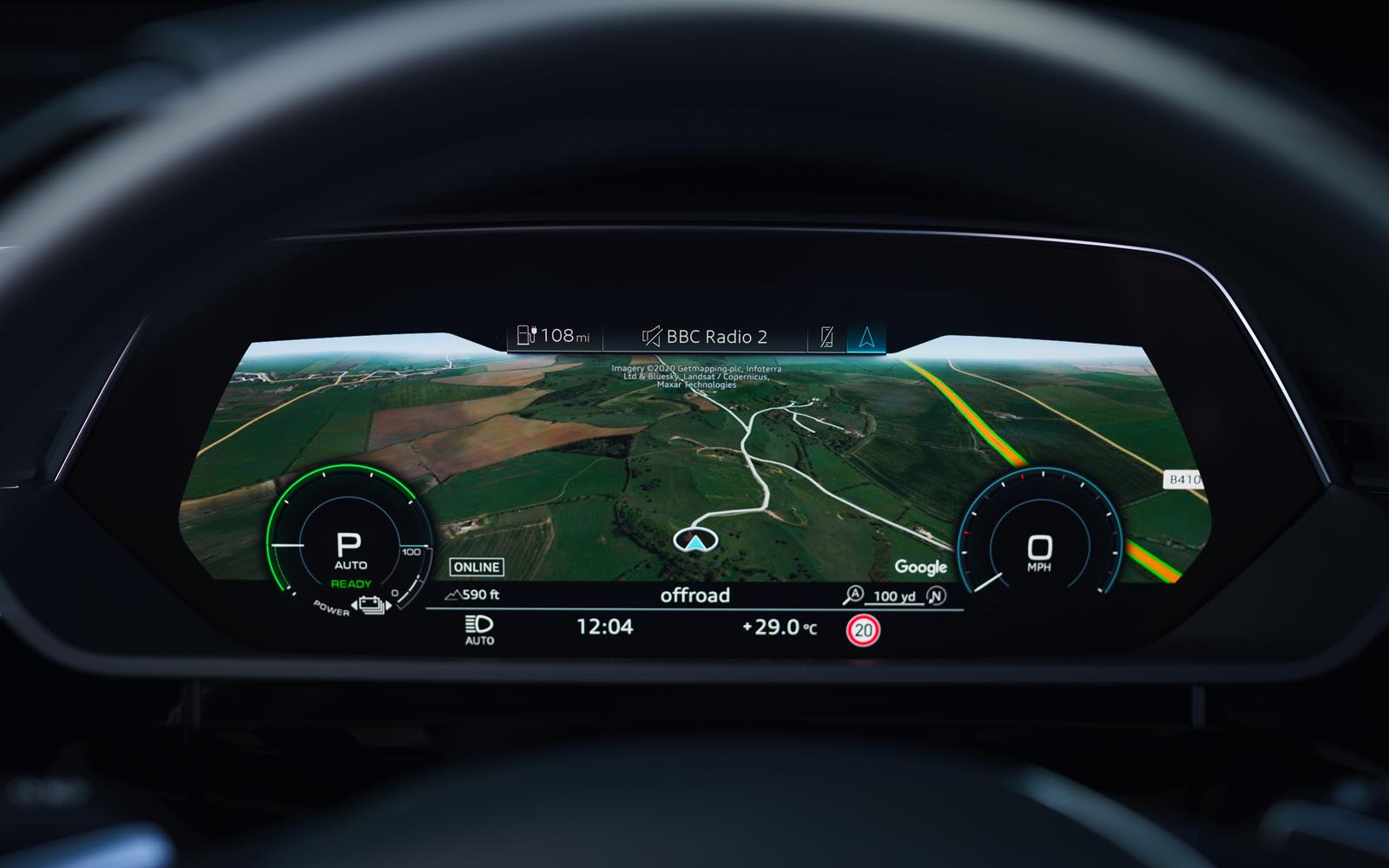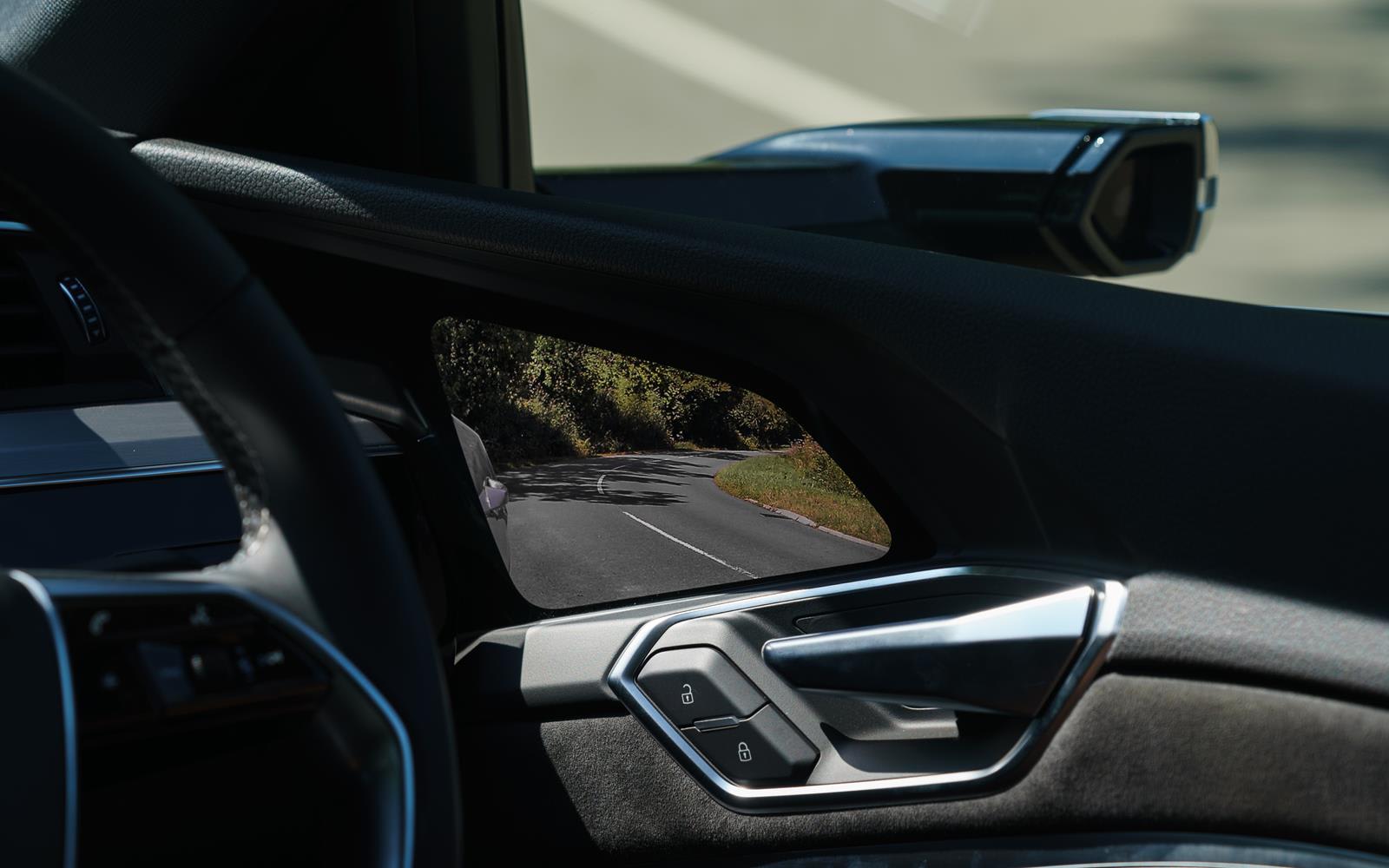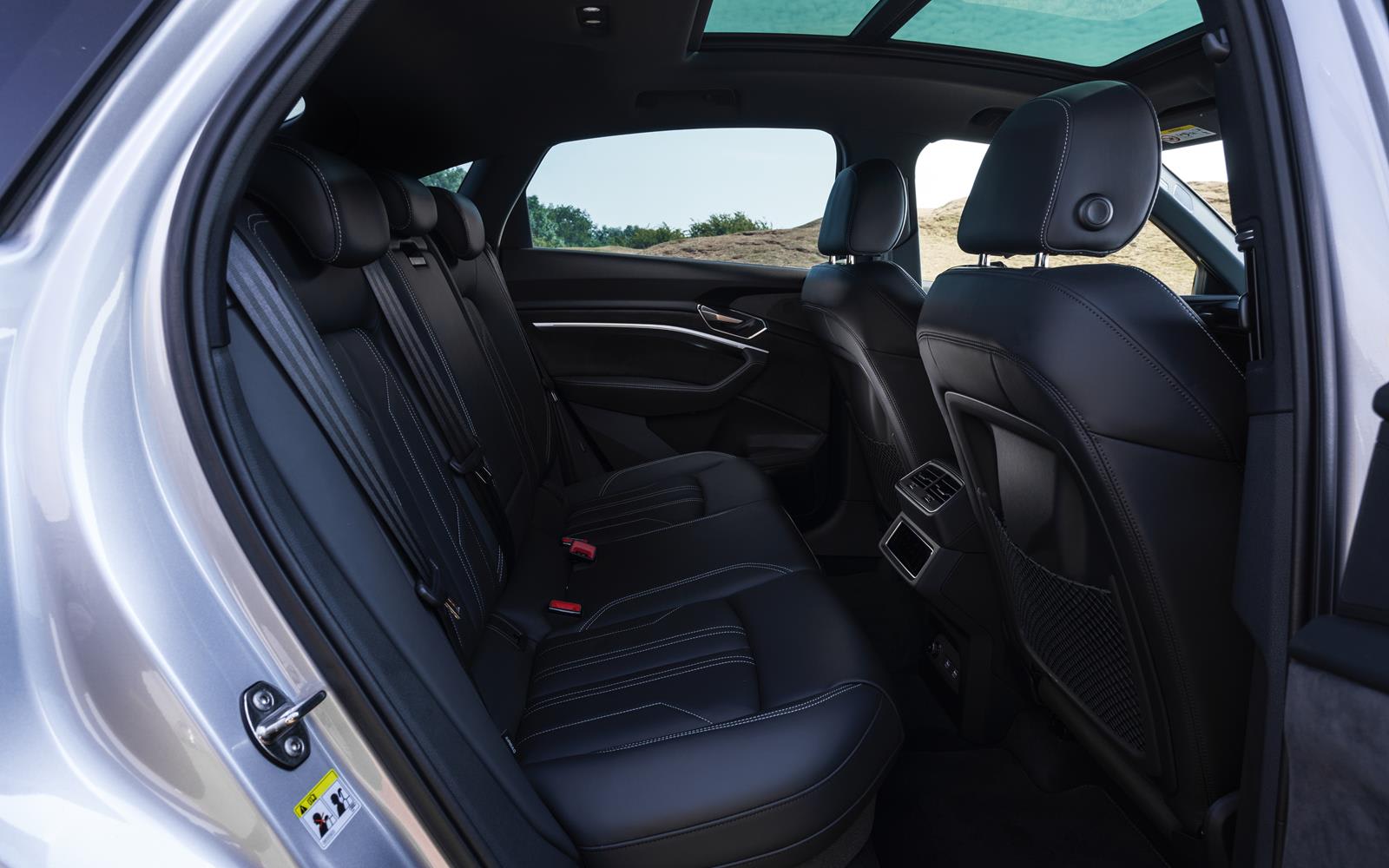
Audi e-tron Sportback Review

Introduction
If you want the size and space of a full-size SUV, but also want something that looks sporty and stylish, your options are quite limited. If you want all that with a battery pack and electric motor rather than a big petrol or diesel engine, then you’re cutting your choices even further.
Fortunately, Audi spotted the niche and created the e-tron Sportback, its all-electric SUV-cum-coupe with the option of all-wheel-drive, supercar-rivalling 500hp performance, and enough space to keep a labrador happy.
Some more sensible models are still quite quick, go a little further, but cost a lot less. There’s no escaping the fact that its near-identical twin, the e-tron (no Sportback) offers much the same, with a little more space and a little less cost. Is it worth paying more for less?
Review Sections
Select's rating score* - 4 / 5
At a Glance
The e-tron Sportback range is somewhat limited, with just three trim levels (S line, First Edition and Vorsprung) and an extra sporty ‘S’ model that Audi considers to be a separate car. It isn’t.
Ignore the S and there’s just two power options to choose from, the unintuitively titled 50 or 55. The 50 is quick and can go on for up to 203 miles before the battery is depleted (at least according to official WLTP figures) while the 55 is slightly quicker and can go on for another 57 miles.
As the entry-level is the well-specified S line trim level, there’s little reason to look much further unless you really must have the latest gadgets, which brings the choice down to range - are 203 miles really enough, or do you need more?

Key Features
The fact that the e-tron is a large SUV with an electric motor is the single biggest key feature, and it’s that combination that will specifically appeal. You can take the family, the dog and maybe a picnic basket for two across the country without fear of adding to the UK’s CO2 mountain. Just don’t ask too many questions about the energy used in the production of either the car or the electricity to power it.
It’s not sacrificed an ounce of Audi DNA though, with the e-tron Sportback sharing the same neat but aggressive design you’ll find across the entire range, but this time boosted by the addition of some high-tech toys.
Most visible are the virtual wing mirrors - video camera instead of reflective glass - but the car is loaded with gadgets and gizmos that wouldn’t look out of place in Shibuya.

Performance and Drive
Performance is always relative. The Audi e-tron 55 tested here can unleash 408hp to all four wheels and has a mammoth 664Nm of torque available. This should allow for sprint times that could rival Apollo 5 at liftoff but, like the rocket, there’s an awful lot of weight to shift.
Add up the huge body, electric motor and countless heavy batteries and the e-tron Sportback weighs in at around 2.5 tonnes, which is generally considered to be ‘quite heavy’. That impacts performance, with a quick but not particularly noteworthy 0-62mph time of 6.6 seconds. Most of that acceleration is done at low speeds where, along with most electric cars, it feels rather more alive. Let the speeds increase and the motor responses dull, leaving it feeling a little lethargic at times.
Opt for the e-tron 50 and you make do with 312hp, but there’s less weight so performance isn’t impacted too significantly. A more powerful ‘S’ model boosts output to 503hp and allows for proper sportscar-rivalling acceleration, but it sacrifices some range.
Huge brakes bring the behemoth to a stop quickly, but it’s how it does it that impresses. A quick regenerative braking lesson: when slowing down, EVs use the electric motors as a dynamo instead of the physical brakes at the wheels, using resistance to gather up energy from the car slowing to charge the battery ever so slightly. As the car gets slower, the braking effect of that energy gathering is reduced, and the brakes have to get involved.

The handover between the motors collecting that energy and the brake discs on the wheels taking over the bulk of the stopping power is sometimes a clunky affair, but it’s imperceptible on the e-tron. It leaves the car feeling predictable, and allows for smoother driving, which will impress your passengers.
Despite the word ‘sport’ appearing in the name, the e-tron is geared towards wafting rather than racing. Adaptive air suspension keeps the huge 21-inch wheels well isolated, with different drive modes changing the driving dynamics of the heavy SUV.
Sport mode stiffens the car appreciably, sacrificing comfort but adding a level of body control that provides real confidence. Comfort, rather obviously, goes the other way around. An automatic mode offers the best of both, leaving the car in a comfortable setting until it detects some more enthusiastic driving when it then stiffens everything to provide that reassuring control.
It works well, leaving the car in its best setting unless it feels that you really need a little more help.
Running Costs
With no petrol tank needing to be refilled, one of the largest costs of running a car has been removed. However, there’s still the small issue of the £80,000 or so asking price, or roughly £700 a month.
Despite that, it can make a lot of financial sense for company car drivers, thanks to the 1% BIK burden. This drops the company car tax bill to around £320 a year, rather than £8,000 or so for a comparable Q7 powered by a diesel or petrol engine.
Private users won’t see that benefit but can console themselves with zero-rated vehicle tax, saving them £150 a year.

Servicing is required just once every two years, or 18,000 miles if you get through those more quickly, which should keep downtime to a low level and costs under control.
However, even with low running costs and low taxation, and without the need for petrol or diesel, it’ll still cost quite a bit in electricity. The official 257-mile range is a tad optimistic, with a week’s worth of mixed driving showing an average of around 200 miles being more realistic.
On an average home energy tariff charging around 15p per kWh, that works out at roughly seven pence per mile. Start filling up at expensive motorway-based chargers and you’ll end up paying more than you would for a tank of diesel.
Interior
Is there a manufacturer making more minimalist, stylish interiors? I’d hazard a guess not. Usability is a different matter, but there’s no doubt that the Audi’s cabin is a masterclass in simple, elegant yet high-tech design.
While most manufacturers opt for a now-conventional layout of an infotainment screen sat high above some ancillary controls, Audi adds another screen instead. While your usual infotainment controls sit in the normal high-mounted screen, behind smartphone-esque polished glass, a second screen is mounted lower down that looks after heating and ventilation, and other secondary systems.
It looks magnificent, with high-definition graphics on both screens, while haptic feedback lets you know when you’ve pressed a button. But, of course, there's not a physical button, so you will need to look down to see where on the screen your finger is pointing.

A third screen replaces the traditional instrument panel in front of the driver. This ‘Virtual Cockpit’ works well, replacing dials and gauges with digital equivalents, but also allowing for different configurations best suited to your needs at the time. Using the navigation setting, for example, sets the speed and other information to the sidelines, and places a large navigation screen right in front of the driver. There’s even an option to use satellite imagery, so you can see the actual buildings, junctions and even things like trees - that’s handy when looking for a near-invisible turning on a country road for example.
If the dashboard is high tech, the rest of the cabin is fairly conventional. Big, comfy seats up front are better than the rear bench, as you might expect, but there’s nothing that anybody would find uncomfortable, tight for space, or ungainly. It’s a triumph of style, but sometimes over function.

Technology
Let’s talk about those wing mirrors, or rather the lack of them. Replacing the traditional mirrors with video cameras is an option on the S line model tested here (although the car was fitted with them) and standard on the Launch and Vorsprung models.
Instead of those bulky ears sticking out of the side of the car, you get a pair of spindly sticks with an embedded camera in each. These broadcast an image of the outside world two a pair of small monitors in the door panels, in roughly the same place as you’d look for a normal door mirror, but slightly lower down.
It looks a million dollars. It’s like the future has finally arrived, with just hoverboards left to tick off the list, with a crisp and clear image on the displays. That’s especially true at night, where the system extracts more information from the darkness behind than the human eye can manage.

However, it’s not all sunshine and rainbows. Despite a reasonably wide-angle lens, your view is restricted to the field of view of the camera. There's no ability to crane your neck a little and see an alternative angle, something that’s particularly frustrating when reversing into a tight gap. Judging distances can be tricky too, with perspective on the flat display difficult to get to grips with. They say objects in the rearview mirror may be closer than they appear, but it’s a bit of a guess to figure out how far away anything really is.
The benefits, I assume, are that it’s more aerodynamic and therefore energy efficient. On a chunky SUV that weighs 2.5 tonnes, the benefit of that is probably rather muted, while the cost of replacing a damaged unit is likely to be significantly higher than replacing a piece of mirror glass.
I’m all for new technology where it has a positive impact, but this feels like technology purely for the sake of it.

Practicality & Boot Space
Swapping the e-tron’s upright stance for something more svelte has impacted practicality, but not by any significant margin. The steeply-raked boot lid eats into the capacity, but you can still squeeze 615-litres of cargo under the Sportback’s parcel shelf. That compares to 660 litres of the SUV variant and is still more than you’ll find in a Volvo V90.
Headroom is impeded in the rear seats but, again, by nothing particularly significant. Even after losing a few centimetres, there’s more than enough for all but the very tall, while impressive legroom ensures you’re left feeling like there’s acres of space.
The front seats are a mixed bag, thanks to the huge centre console. This wide expanse separates the driver and passenger and can make things feel slightly cramped, but there’s so much room made available that the reality is far different. The console also introduces a few extra storage areas including an enormous cubby beneath the armrest.

Safety
Euro NCAP hasn’t tested the Sportback yet, but the regular e-tron SUV is mechanically identical. When the agency tested that vehicle back in 2019, it scored the maximum five-star rating, and there’s no reason to suspect that the Sportback would perform any differently.
Despite its blunt front end, pedestrians and other vulnerable road users are well protected, but it’s those on the inside that fare best - all passengers, whether adult or child and regardless of where they’re sat, are impressively cocooned.
Every e-tron Sportback gets automatic emergency braking and lane-keeping assistance as standard, but there’s a long list of optional safety kit if you want more protection; side airbags in the rear, adaptive cruise control, traffic sign recognition, collision avoidance assistant, cross-traffic and turn assist, a 360-degree camera, and lane departure assist are all relegated to the options list.
Options
It’s often a case of knowing when to stop when it comes to speccing up an Audi. The manufacturer doesn’t claim to make personalised cars, but there’s such a wide array of options that there’s every chance you can create one.
The easy solution to wanting more equipment is to simply specify the next model up in the range, but the entry-level here is S line, and that already comes with most gadgets and gizmos you might want.
Splashing out on the Tour Pack will make life easier thanks to the addition of adaptive cruise control. It also brings traffic-sign recognition and a suite of extra safety enhancements, from collision avoidance assist to lane departure warning. Interestingly, it includes predictive efficiency assist which gives you gentle nudges to drive more efficiently by doing things as vibrating the accelerator pedal as you approach a roundabout, encouraging you to coast up to it rather than power along and brake sharply.
An extra £1,895 gets you a Bang & Olufsen sound system, with 3D sound, 705 watts of power, and a 15-channel amp. The Comfort and Sound pack it’s included in also adds extra lighting around the car, with multi-coloured ambient lighting, as well as keyless entry and start and a 360-degree surround-view camera.
A panoramic roof will lighten up the interior, but that’s an extra £1,475, while high-tech virtual wing mirrors add a dramatic and stylish touch but will add another £1,250 to the price tag. If you want your e-tron in any colour other than back, that’ll be an extra £750.

Rival Cars
The SUV sector is bristling with electrical-powered models, and one of the best known is Jaguar’s I-Pace. This follows the e-tron’s somewhat coupe-like style and offers slightly sharper handling and an appealing badge on the bonnet. Its promised range is higher than the Audi, and the car is also a little cheaper.
A more conventional SUV shape wraps around the Mercedes-Benz EQC. Impressive navigation technology onboard reduces range anxiety, which is handy as the range isn’t huge. Room isn’t as plentiful inside as you might expect though, as it’s built around the existing GLC model rather than being designed specifically as an EV.
The poster boy of the EV world, Tesla, also needs to be mentioned. Its Model X catches attention with its spectacular falcon-wing doors, but the car is spectacularly quick and impressively spacious. The real-world range can be disappointing though, and build quality leaves a lot to be desired.
Verdict & Next Steps
The e-tron Sportback brings a sense of style and presence to the e-tron, as well as a slightly sharper ride than its SUV sibling, but sacrifices some practicality in the process. It’s also a little more expensive, but is that a price worth paying for the sleek style?
Arguably, it could be. Thanks to strong residual values, leasing a like-for-like Sportback is marginally cheaper than the regular SUV, and only really loses a small amount of boot space to its bigger brother. Unless that 45-litres of lost boot space, or the squarer upright stance, is critical to you, the Sportback is the model to go for.
Where to next?
View latest Audi e-Tron Sportback leasing deals- from £608.94 per month inc VAT**
Looking for a great deal? Check out our incredible range of car lease deals
New luxury SUV? Read our latest Car Reviews and find the right model for you
Want to know more about leasing? Take a look at our comprehensive Leasing Guides
Interested in everything motoring? Why not catch up on all the latest Car Leasing News.
*Score based on Select’s unique meta score analysis, taking into account the UK’s top five leading independent car website reviews of the Audi e-Tron Sportback
**Correct as of 09/04/2021. Based on 9 months initial payment, 5,000 miles over a 48 month lease. Initial payment equivalent to 9 monthly payments or £5480.46 Ts and Cs apply. Credit is subject to status.



















